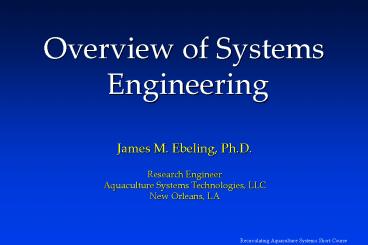Overview of Systems Engineering - PowerPoint PPT Presentation
Title:
Overview of Systems Engineering
Description:
Recirculating Aquaculture Systems Short Course Overview of Systems Engineering James M. Ebeling, Ph.D. Research Engineer Aquaculture Systems Technologies, ... – PowerPoint PPT presentation
Number of Views:145
Avg rating:3.0/5.0
Title: Overview of Systems Engineering
1
Overview of Systems Engineering
- James M. Ebeling, Ph.D.
- Research Engineer
- Aquaculture Systems Technologies, LLC
- New Orleans, LA
2
Overview of Unit Operations
Aeration Air/Oxygen
Carbon Dioxide Removal
Fish Culture Tank
Disinfection
Fine Dissolved Solids Removal
Biofiltration Nitrification
Sludge
Waste Solids Removal
BIOSECURITY
Sludge
Monitoring System Control
3
Overview of System Design
Aeration Air/Oxygen
Carbon Dioxide Removal
Fish Culture Tank
Monitoring System Control
Disinfection
Fine Dissolved Solids Removal
Biofiltration Nitrification
95
5
Suspended Solids
Settable Solids
Sludge
Sludge
Sludge
Biosecurity Program
4
Why Reuse Water?
- Minimize water use
- conserve heat
- Note, heat gain can be problem in some coldwater
systems. - decrease water demand
- decrease wastewater discharge volume
- reduce TMDL discharged
5
Why Reuse Water?
- Increase biosecurity
- locate on smaller pathogen-free ground water
resources - smaller inlet flows are cheaper to disinfect
- smaller discharge flows are easier to screen and
prevent escapement - locate farm away from regions with known pathogen
problems
6
Why Reuse Water?
- Cold-water reuse systems
- in Canada
- reuse water to increase 4-8ºC ground water to 10
to 15ºC - increased growth rates off-sets higher capital
cost - in northern USA
- ground water already 11 to 13ºC (near ideal
temperature) - reuse water to increase production on a given
water resource - increased production must offset higher capital
costs - reuse water to decrease waste discharge
7
Culture Tank
Fish Culture Tank
Anything that holds water
8
Polyethylene Tanks
9
Fiberglass Tanks
10
Fiberglass Tanks
11
Fiberglass Tanks
12
Plywood/Wood Tanks
13
Steel Tanks
14
Corrugated Panels with Liner
Aluminum
Steel
15
Plywood/Wood Raceways
16
Concrete Tanks/ Raceways
17
Aquarium Systems
18
Settable Solids Removal
5
Settable Solids
Sludge
- Bottom-drawing center drain
- Settling basins
- Swirl separators/ Hydrocyclones
Rule of Thumb 1 lb of feed ? 0.30 lbs of solids
19
Center Dual-Drain System
20
Settling Basin
21
Swirl Separator
22
Suspended Solids Removal
95
Suspended Solids
Sludge
- Screen filtration
- rotating microscreens
- horizontal screen
- vertical screen
- Pressurized bead filters
- Pressurized sand filters
23
Rotating Microscreen Filter
24
Horizontal Screen Filter
25
Inclined Screen Filter
26
Pressurized Bead Filters
27
Pressurized Sand Filters
28
Fine Dissolved Solids
Fine Dissolved Solids Removal
- Foam Fractionation
Sludge
- Protein Skimmers
29
Solids Disposal
Sludge
- GeoBags
- land application
- composting
- lagoons
30
GeoTextile Bags
31
Vacuum Honey Wagon
32
Waste Lagoon
33
Compost Bin
34
Biofiltration / Nitrification
Biofiltration Nitrification
Ammonia Oxidizing Bacteria
2 NH4 OH - 3 O2 ? 2 H 2 NO2- 4 H2O
Ammonia Nitrite
Nitrite Oxidizing Bacteria
2 NO2 1 O2 ? 2 NO3-
Nitrite Nitrate
35
Biofiltration / Nitrification
Biofiltration Nitrification
1 g of ammonia yields
4.42 g nitrate NO3-
5.93 g carbon dioxide
consumes
4.34 g oxygen
7.14 g alkalinity
Rule of Thumb 1 kg feed ? about 0.03 kg ammonia
36
Biofiltration / Nitrification
Biofiltration Nitrification
- Submerged Biofilters
- Trickling Biofilters
- Rotating Biological Contactors (RBC)
37
Gravel Biofilter
38
Submerged/Trickling Biofilter
39
Submerged Foam Filter
40
Classic Trickling Tower
41
Trickling Tower Spray Bar
42
Smaller Version
43
Rotating Biological Contactors
44
RBC Drive Shaft
45
Biofiltration / Nitrification
Biofiltration Nitrification
- Pressurized bead biofilters
- Fluidized sand biofilters
- Fluidized bead biofilters
- Moving bed BioReactors
46
Propeller Washed Bead Filter
47
Bubble Washed Bead Filter
48
Drop Filters (PolyGeysers)
49
Fluidized Bed Biofilters
50
Downflow micro-bead biofilter
51
Moving Bed Biofilter
52
Aeration / Oxygenation
Aeration Air/Oxygen
Oxygen Requirements
- Metabolism/respiration 0.25 lbs O2 / lb feed
- Nitrifying bacteria 0.40 lbs O2 / lb feed
Total 0.65 to 1.00 lbs of O2 / lb feed
53
Sources of Air - Blowers
54
Aeration / Oxygenation
Aeration Air/Oxygen
Aeration (less than 1/3 lb of fish / gal of water)
- Diffusers (air stones)
- Mechanical agitators
- Packed column aeration
55
Air Lifts - Mechanical Aeration
56
Aeration Tower
57
Aeration / Oxygenation
Aeration Air/Oxygen
Oxygenation
sources compressed oxygen cylinders
liquid oxygen (LOX) on-site oxygen
generation
- Downflow Bubble Contactor
- Counter Current Diffusion Column
- Multi-stage Low Head Oxygenation (LHO)
58
Oxygen Sources
on-site oxygen generators
59
LOX
60
Emergency Supply
61
Downflow Bubble Contactor
62
Full Scale Speece Cone
63
Carbon Dioxide Removal
Carbon Dioxide Removal
- Packed column degassing units
64
Disinfection
Disinfection
- Ultraviolet radiation
- Ozone
65
Monitoring System Control
Monitoring System Control
- Continuous
- DO
- Level
- Flow
- Temperature
- Air pressure
- Periodically
- pH
- NH3
- NO2
- NO3
- CO2
- Alkalinity
Phone Dialer
It takes only one mistake to KILL EVERYTHING IN
YOU FACILITY!!!!
66
Continuous Monitoring
67
Water Quality Lab
68
BioSecurity
69
Support Components
- Water Quality Lab
- Storage - Feed, Chemicals, Product
- Equipment Storage
- Staff Support
- Back-up Generator
- Quarantine Area
- Waste Disposal
70
SAFETY
Water and electricity do not mix!
- Have Back-up Plans and Use Them!
- Train staff in emergency preparedness!
- Think!!!
71
SAFETY
The Good!
Mercury!!
The Ugly!!
The Bad!
72
Putting It All Together
Aeration Air/Oxygen
Carbon Dioxide Removal
Fish Culture Tank
Disinfection
Fine Dissolved Solids Removal
Biofiltration Nitrification
Sludge
Waste Solids Removal
BIOSECURITY
Sludge
Monitoring System Control
73
Questions?































